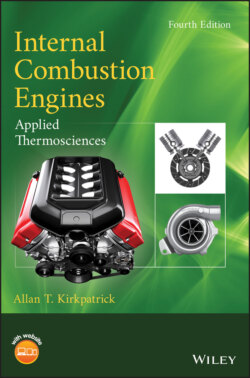Читать книгу Internal Combustion Engines - Allan T. Kirkpatrick - Страница 40
Fuel Cells
ОглавлениеA fuel cell converts the chemical energy in a fuel directly to electricity through electrochemical reactions. The first fuel cell was invented by W. Grove, an English scientist, in 1838. For vehicular applications, hydrogen is used as the fuel, and oxygen is the oxidizing agent. Fuel cell technology competes well in applications requiring reduced emissions, as recent developments in polymer‐electrolyte membrane (PEM) technology indicate that a PEM fuel cell produces much lower emissions relative to an internal combustion engine. A PEM fuel cell operates with hydrogen supplied to the anode, and oxygen supplied to the cathode.
Both the anode and cathode are composed of platinum particles embedded in a substrate surface of porous carbon. At the anode, the hydrogen is split into protons and electrons in the reaction . The protons migrate through a polymer electrolyte to the cathode, and the electrons provide the required current across the external load circuit, such as a battery. At the cathode, the oxygen reacts with the protons and electrons to form water, in the reaction .
Current PEM fuel cell stacks are small enough to fit beneath a vehicle's floor next to the storage batteries and currently can deliver up to 125 kW to an electric motor. Studies indicate that the best opportunities for fuel cell adoption are in the commercial vehicle market, i.e., trucks and off‐highway applications. Since there is presently no hydrogen fuel storage infrastructure, one option is on‐board reforming of methanol fuel to hydrogen and . The reforming efficiency is about 60%, so coupled with a fuel cell efficiency of 70%, and a motor efficiency of 90%, the overall fuel cell engine efficiency is of the order of 40%, about the same as a high‐efficiency internal combustion engine.
